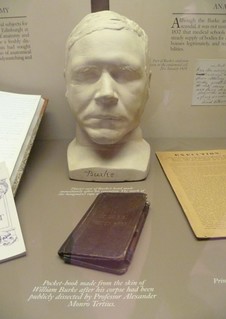
PREV ARTICLE
NEXT ARTICLE
FULL ISSUE
PREV FULL ISSUE
THE ANTHROPODERMIC BOOK PROJECT
Just in time for Halloween comes this article about a study of the creepiest books of all, those bound in human skin. Thankfully, there are no known numismatic books thus bound.
-Editor
Real anthropodermic books do exist, originating in France as well as Britain and the United States and primarily created in the nineteenth century. The most legendary French skin tomes—Marquis de Sade’s Justine et Juliette bound in a woman’s skin or French erotica with a visible human nipple on the cover—prove to be the most difficult to find. Such dark curiosities are tucked away in private collections (if they exist at all) and difficult to examine and determine if they are really human leather. Only now is it scientifically possible to separate reality from myth. I am a member of a team of chemists, librarians, and museum professionals at the Anthropodermic Book Project who have identified forty-seven allegedly anthropodermic books in public libraries and museums. Of the thirty we have tested so far, twelve have bindings from a nonhuman animal of origin and eighteen are indeed tanned human skin. The scientific process of peptide mass fingerprinting, or PMF, uses unique peptide markers in the collagen of each animal family to determine the leather’s source. The DNA in these books is too degraded from time and tanning to be successfully extracted by today’s testing methods. With the PMF test we now know that the College of Physicians of Philadelphia’s 1709 copy of John Locke’s An Essay on Human Understanding (Libri IV de intellectu humanu), highly influential among the thinkers of the French Revolution, is bound in cattle hide, contrary to the inscription by an Ethel Barnett that claimed: “This ancient book has Latin within and is bound in a nice little piece of my skin.” Testing of a 1671 prayer book at the University of California’s Bancroft Library (the book’s inscription states it was rebound in the skin of its former owner, a clergy member executed in the French Revolution) found that its pebbly black cover comes from a horse, not a human. Yet the binding on Brown University’s copy of Mademoiselle Giraud, My Wife, the controversial 1891 French novel with lesbian themes by Adolphe Belot, is indeed of human origin, as are three seventeenth-century French gynecological works, which at some point were bound in the skin of a poor American woman who died of trichinosis and tuberculosis in a Philadelphia hospital in 1868. Scratching the surface of the history of any real human-skin book usually reveals a doctor was the one wielding the knife. At a time when physicians were climbing social classes and enjoying the trappings of their new wealth and status—including becoming collectors of fine art and books—at least a few chose to preserve the hides of deceased indigent patients to bind copies of their own work or of those that they admired, like anatomist Andreas Vesalius. (Brown University’s Hay Library holds a large, beautiful anthropodermic Vesalius, in addition to three other books proved to be bound in human skin.) At the same time, public executions were one of the only legal sources for obtaining bodies for dissection. Doctors sometimes removed the skins of infamous murderers and used them to bind books about their deeds—a fact well known enough to serve as a kind of deterrent. The most infamous case is the pocket-sized book bound in the skin of William Burke, half of the Scottish duo Burke and Hare, who murdered sixteen people in order to sell their bodies to doctors for dissection. Like his unfortunate victims, Burke could not escape the anatomist’s knife in the end, and his skin book resides in Surgeons’ Hall Museum in Edinburgh. While doctors today refuse to participate in executions, citing the principle of “first do no harm,” doctors in the eighteenth and nineteenth centuries worked with their governments to ensure their access to dead bodies for anatomical learning.
To read the complete article, see:
As noted in the article, the Anthropodermic Book Project has tested 30 books so far. 18 were confirmed as bound in human skin; 12 were proven not to be. Here's the project web site.
-Editor
Our team has developed an easy, inexpensive, and truly authoritative method for testing alleged anthropodermic books to see if they’re of human origin. Our goal is to create a census for the alleged anthropodermic books of the world and test as many as possible to learn the historical truths behind the innuendo. We keep our partner institutions’ results anonymous unless we get their permission to share.
To visit the Anthropodermic Book Project web site, see:
To read earlier E-Sylum articles, see:
The Numismatic Bibliomania Society is a non-profit organization promoting numismatic literature. See our web site at coinbooks.org. To submit items for publication in The E-Sylum, write to the Editor at this address: whomren@gmail.com To subscribe go to: https://my.binhost.com/lists/listinfo/esylum All Rights Reserved. NBS Home Page Contact the NBS webmaster 
|
